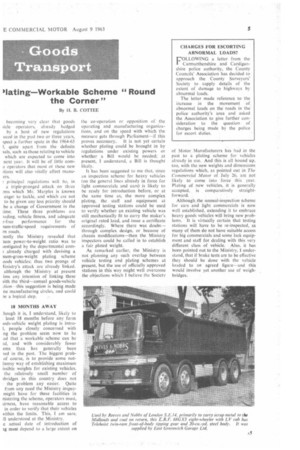lilating—Workable Scheme "Round the Corner"
Page 7

If you've noticed an error in this article please click here to report it so we can fix it.
By 11, B. COTTEE becoming very clear that 'mods lick operators, already hedged by a host of new regulations need in the past two or three years, siva a further spate in the 1964-65 I, quite apart from the definite sals, such as those relating to vehicle which are expected to come into next year. It will be of little corn Operators that most of these new itions will also vitally affect manners.
! principal regulations will be, in a triple-pronged attack on three sms which Mr. Marples is known eager to tackle, and which are not to be given any less priority should be a change of Government in the Lime. These three problems are }ading, vehicle fitness, and adequate .-free performance for the sum-traffic-speed requirements of rn roads.
:ently the Ministry revealed that min power-to-weight ratio was to iestigated by the departmental corn already charged with devising a num-gross-weight plating scheme oods vehicles; thus two prongs of 1inistry's attack are already linked. although the Ministry at present ims any intention of linking these vith the third—annual goods-vehicle :tion--this suggestion is being made ne manufacturing circles, and could De a logical step.
18 MONTHS AWAY
hough it is, I understand, likely to least 18 months before any form iods-vehicle weight plating is intro!, people closely concerned with ng the problem seem now to be .ed that a workable scheme can be NJ, and with considerably fewer ems than has generally been led in the past. The biggest probof course, is to provide some notlumsy way of establishing maximum issibie weights for existing vehicles, the relatively small number of 'bridges in this country does not the problem any easier. Quite from any need the Ministry inspecmight have for these facilities in nistering the scheme, operators must, iirness, have reasonable access to in order to verify that their vehicles within the limits. This, 1 am sure, 111 understood at the Ministry.
e actual date of introduction of sg must depend to a large extent on the co-operation or opposition o the operating and manufacturing organitaLions, and on the speed with which the measure gets through Parliament—if this
proves necessary. It is not yet certain whether Plating could be brought in by regulations under existing powers or whether a Bill would be needed; at present, I understand, a Bill is thought likely.
It has been suggested to me that, since an inspection scheme for heavy vehicles Ion the general lines already in force for light commercials and cars) is likely to be ready for introduction before, or at the same time as, the more complex plating, the staff and equipment at approved testing stations could be used to verify whether an existing vehicle was still mechanically fit to carry the maker's original rated load, and issue a certificate accordingly. Where there was doubt— through complex design, or because of chassis modifications—then the Ministry inspectors could be called in to establish a fair plated weight.
As remarked earlier, the Ministry is not planning any such overlap between vehicle testing and plating schemes at present, but the use of officially approved stations in this way might well overcome the objections which T believe the Society of Motor Manufacturers has had in the past to a plating scheme for vehicles already in use. And this is all bound up, too, with the new weights and dimensions regulations which, as pointed out in The Commercial Motor of July 26. are not likely to come into force this year. Plating of new vehicles, it is generally accepted, is comparatively straightforward.
Although the annual-inspection Scheme for cars and light commercials is now well established, extending it to embrace heavy goods vehicles will bring new problems. It is virtually certain that testing stations will have to be re-inspected, as many of them do not have suitable access for big commercials and some lack equipment and staff for dealing with this very different class of vehicle. Also, it has been pointed out to the Ministry, I understand, that if brake tests are to be effective they should be done with the vehicle loaded to an agreed figure—and this would involve yet another use of weighbridges.
































































































































